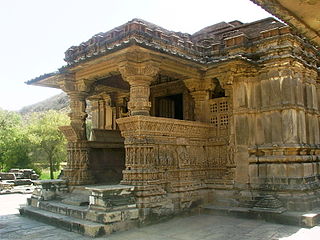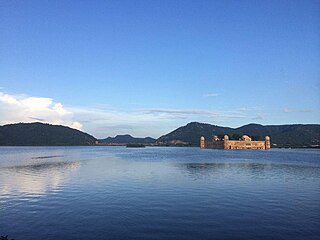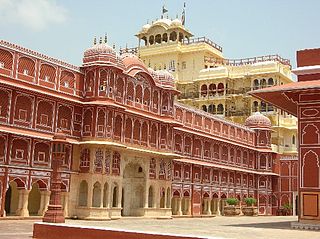Gallery
- Digamber Jain temple of Sanghiji, Sanganer
- Birla Mandir
- Galtaji Temple
- Kanak Vrindavan
This is a list of attractions in Jaipur city in Rajasthan state in India. [1] [2]

Jaipur is the capital and the largest city of the north-western Indian state of Rajasthan. As of 2011, the city has a population of 3.1 million, making it the tenth most populous city in the country. Located 268 km from the national capital New Delhi, Jaipur is also known as the Pink City due to the dominant color scheme of its buildings in old city.

The Kachhwaha is a Rajput clan found primarily in India.

Dhundhar, also known as Jaipur region, is a historical region of Rajasthan state in western India. It includes the districts of Jaipur, Neem ka Thana, Dantaramgarh part of Sikar District lying to the east of the Aravalli Range, Dausa, Sawai Madhopur, Tonk, the southern part of Kotputli and the northern part of Karauli District.

Amer Fort or Amber Fort is a fort located in Amer, Rajasthan, India. Amer is a town with an area of 4 square kilometres (1.5 sq mi) located 11 kilometres (6.8 mi) from Jaipur, the capital of Rajasthan. Located high on a hill, it is the principal tourist attraction in Jaipur. Amer Fort is known for its artistic style elements. With its large ramparts and series of gates and cobbled paths, the fort overlooks Maota Lake, which is the main source of water for the Amer Palace.

Rajasthan, a state in western India, has had a close historical connection with Jainism. Southwestern Rajasthan was the main centre for Śvetāmbara Jainism. Major Digambara centres are in the northern and eastern parts of Rajasthan. Central and Northern Rajasthan are the main centres for the Terapanth sect of Śvetāmbara Jainism.

Jal Mahal is a palace in the middle of the Man Sagar Lake in Jaipur city, the capital of the state of Rajasthan, India. The palace was originally constructed around 1699; the building and the lake around it were later renovated and enlarged in the early 18th century by Maharaja Jai Singh II of Amber.

Jaigarh Fort is situated on the promontory called the Cheel ka Teela of the Aravalli range; it overlooks the Amer Fort and the Maota Lake, near Amer in Jaipur, Rajasthan, India.

Nahargarh Fort stands on the edge of the Aravalli Hills, overlooking the city of Jaipur in the Indian state of Rajasthan. Along with Amer Fort and Jaigarh Fort, Nahargarh once formed a strong defence ring for the city. The fort was originally named Sudershangarh, but it became known as Nahargarh, which means 'abode of tigers'. The popular belief is that Nahar here stands for Nahar Singh Bhomia, whose spirit haunted the place and obstructed construction of the fort. Nahar's spirit was pacified by building a temple in his memory within the fort, which thus became known by his name.

The architecture of the Indian state of Rajasthan has usually been a regional variant of the style of Indian architecture prevailing in north India at the time. Rajasthan is especially notable for the forts and palaces of the many Rajput rulers, which are popular tourist attractions.

Rajasthan, the largest state in India, is known for its rich cultural heritage, vibrant traditions, and historical significance. The Culture of Rajasthan which developed over the past millennia, is a blend of various elements, including music, dance, cuisine, festivals, art, and architecture.

In Jainism, a Bhonyra is an underground chamber with Jain images. In the past, it was used to conceal sacred idols during times of disturbance.

Rajasthan is one of the most popular tourist destinations in India, for both domestic and international tourists. Rajasthan attracts tourists for its historical forts, palaces, art and culture with its slogan "Padharo Mhare Desh ". The capital city, Jaipur, also known as Pink City, is a very popular tourist destination place and it is a part of the Golden Triangle. The Walled City of Jaipur is only the second Indian city to be recognized as a UNESCO World Heritage Site, after Ahmedabad.

Hill Forts of Rajasthan are six forts, spread across Rajasthan state in northern India. They have been clustered as a series and designated as a UNESCO World Heritage Site in 2013. The hill forts series include—Chittor Fort at Chittorgarh, Kumbhalgarh Fort at Rajsamand, Ranthambore Fort at Sawai Madhopur, Gagron Fort at Jhalawar, Amer Fort at Jaipur and Jaisalmer Fort at Jaisalmer.

Kanak Vrindavan is a garden in Jaipur, the capital of Rajasthan. It is built in a valley surrounded by Aravali hills and is located on the way to the Amer Fort at the bottom of the Nahargarh hill. The place is approximately 8 kilometers north of the Jaipur city. The garden has many nearby tourist attractions such as the Amer fort Palace, Jaigarh fort and Nahargarh Fort along with lush greenery.

Man Sagar Lake is an artificial lake, situated in Jaipur, the capital city of the state of Rajasthan in India. It is named after Raja Man Singh, the then ruler of Amer, who constructed it in c. 1610 by damming the Dravyavati river. The Jal Mahal is situated in the middle of the lake.

Shri Digamber Jain Atishya Kshetra Mandir, Sanghiji is an ancient Jain Temple in Sanganer, Rajasthan made of red stone. The ancient Shri Digamber Jain temple of Sanganer is 16 km from Jaipur.

Rajput architecture is an architectural style associated with the forts and palaces of the many Rajput rulers. Many of the Rajput forts are UNESCO World Heritage Sites and popular tourist attractions.